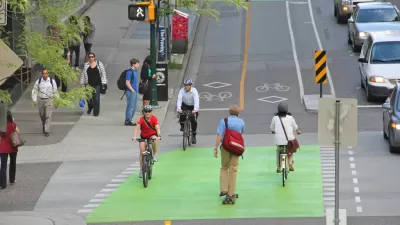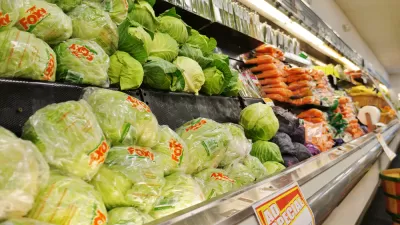Costco may be coming to Manhattan, bringing 2300 parking spaces with it.
Costco may be coming to Manhattan, bringing 2300 parking spaces with it.
In a city where high rents have driven out traditional grocery stores, some are welcoming the news. But is Costco the answer? Their buy-in-bulk business model is meant for big cars and big suburban homes. I don't see how this fits into Manhattan's car-free lifestyle, even if Costco modifies their building design for the urban landscape.
The role of neighborhood grocery stores in building and maintaining walkable communities cannot be overstated. European cities and towns simply would not be the pedestrian utopias that they are without the many small grocers, outdoor markets and specialty shops that make it possible to gather daily provisions without a car.
Small grocers are essential because:
• They fit well into walkable main streets.
• They are small enough to be located within residential communities.
• They don't require a huge parking lot
• They are close enough to housing so that shoppers can carry groceries home, or return several times a day if needed.
Can a neighborhood be considered mixed-use without a decent grocery store? And by decent, I am thinking of businesses that offer a basic variety of fresh, quality products at reasonable prices: Trader Joe's, Wild Oats, a trusted mom & pop grocer, or a local natural foods shop. Mid-sized grocery stores can also work well, provided that they are properly integrated into a city's shopping streets.
It's a common theme throughout suburban and even urban America: few residential neighborhoods are self sufficient when it comes to groceries. The ones that are lucky enough to have the "good stores" attract a lot of traffic from surrounding areas. The small grocery chain Fresh & Easy, subsidiary of the British Tesco empire, continues to expand in the southwestern United States. If the company targets locations that match the scale of its stores and have a walkable street grid, their venture could prove successful as the country trends away from suburban living.

Alabama: Trump Terminates Settlements for Black Communities Harmed By Raw Sewage
Trump deemed the landmark civil rights agreement “illegal DEI and environmental justice policy.”

Study: Maui’s Plan to Convert Vacation Rentals to Long-Term Housing Could Cause Nearly $1 Billion Economic Loss
The plan would reduce visitor accommodation by 25% resulting in 1,900 jobs lost.

Why Should We Subsidize Public Transportation?
Many public transit agencies face financial stress due to rising costs, declining fare revenue, and declining subsidies. Transit advocates must provide a strong business case for increasing public transit funding.

Wind Energy on the Rise Despite Federal Policy Reversal
The Trump administration is revoking federal support for renewable energy, but demand for new projects continues unabated.

Passengers Flock to Caltrain After Electrification
The new electric trains are running faster and more reliably, leading to strong ridership growth on the Bay Area rail system.

Texas Churches Rally Behind ‘Yes in God’s Back Yard’ Legislation
Religious leaders want the state to reduce zoning regulations to streamline leasing church-owned land to housing developers.
Urban Design for Planners 1: Software Tools
This six-course series explores essential urban design concepts using open source software and equips planners with the tools they need to participate fully in the urban design process.
Planning for Universal Design
Learn the tools for implementing Universal Design in planning regulations.
Caltrans
Smith Gee Studio
Institute for Housing and Urban Development Studies (IHS)
City of Grandview
Harvard GSD Executive Education
Toledo-Lucas County Plan Commissions
Salt Lake City
NYU Wagner Graduate School of Public Service





























